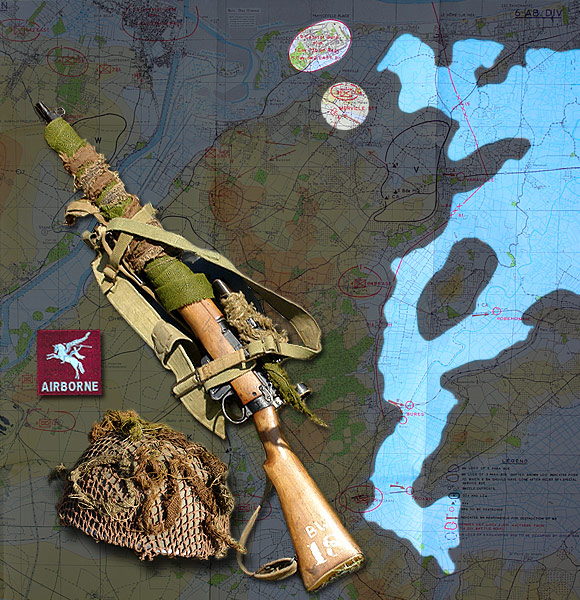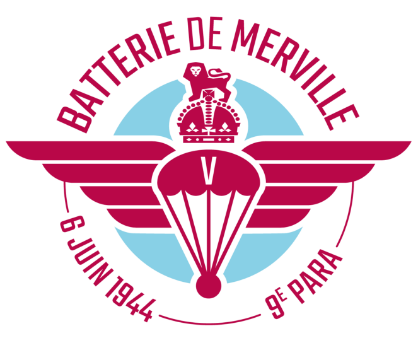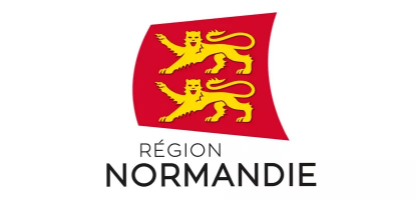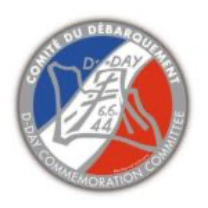The big jump : 6 June 1944
Accueil » The Museum » The Battery » The big jump : 6 June 1944
The planned drop zones
Drop Zone and Landing Zone for the 7,000 paratroopers of the 6th Airborne Division
The intended drop zone for Lieutenant Colonel Otway’s 9th Battalion is indicated by a ‘V’. There were several difficulties for the airborne operation. First, bad weather with a very strong westerly wind increased the risk of being carried further east and into the marshes flooded by Rommel. Second, there was a very short interval between the crossing of the French coast and arrival at Drop Zone V, which is only about 5 km away. This would be all the more critical as the German anti-aircraft defence would be unleashed as the coast was crossed. Thirdly, Drop Zone V borders the vast area flooded by Rommel. All the relief was hidden by water and the depth in some places could be fatal for parachutists with all their gear. Finally, jumping at night would make the drop still more difficult.
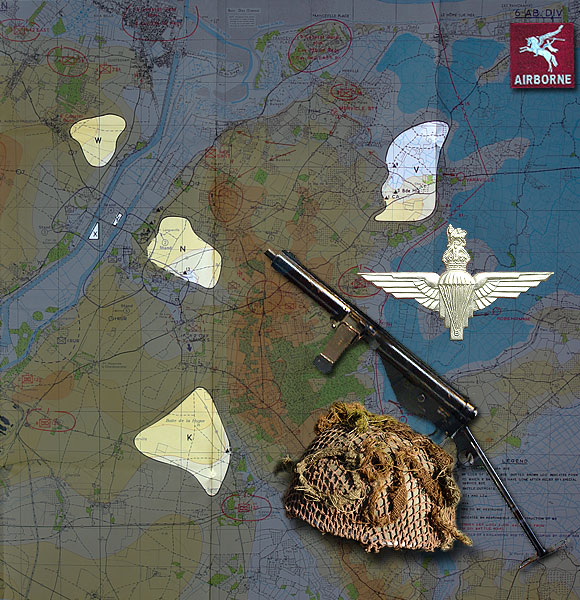


The scouts
Scouts from the 9th Battalion would be the first to take off for Normandy. Several groups of scouts from Lieutenant-Colonel Terence Otway’s 9th Battalion would take off in the first half-hour of D-Day. Half past midnight. The scouts were commanded by Major Alan Parry. Their job was to reconnoitre the Battery so that they could report to Lieutenant Colonel Terence Otway at the Drop Zone rendezvous point, to clear and mark corridors for the assault force, to mark the Drop Zone and rendezvous point, and to guide the 9th Battalion to the Battery, all as discreetly as possible.
The task of shearing the wire, clearing the mines and marking the cleared accesses fell to Sergeant Major Miller.
Meanwhile, in Normandy, the wind lashed the coast relentlessly.
The static lines were attached (automatic parachute opening link attached to a fixed line along the ceiling of the Dakota), the red lights came on followed by the green lights, and the entire stick of parachutists jumped.
Sergeant Major Miller moved quickly with his men through the silence of the night towards the Battery, armed with landmarks well known to him from training near Newbury. Suddenly they heard the distinctive sound of a fleet of Royal Air Force bombers. They had just enough time to throw themselves on the ground as heavy bombs exploded from all sides. They made it – by a miracle. The planned bombardment of the Battery was clearly off target. To their right, Gonneville was in flames. As soon as the deluge of fire had passed, Sergeant Major Miller, in the middle of the dust, resumed his progression as quickly as possible. Time was short, the schedule was tight!
They reached the Battery, having avoided a patrol which made them stop once again. They started their reconnaissance mission, crawled through, cut the barbed wire and then turned back to wait for the de-mining equipment and the tapes marking the safe paths. The paratrooper who was to provide them joined them empty-handed. All the equipment had been completely lost in the drop!
But Sergeant Major Miller did not give up. Together with Lieutenant Paul Greenway, they started clearing mines by hand and marking the ground with their feet.
Alan Parry, after being dropped outside the Drop Zone, eventually joined them.
The take-off of the 'Dak' with 750 men
The 9th Battalion, in all its strength, took off for Normandy
Only two months after first discovering his mission objective in a secret room at Intelligence Headquarters, Lieutenant-Colonel Terence Otway was flying on board a Royal Air Force (RAF) Dakota to his drop zone. The Dakotas, with their large white markings (the hallmark of Operation Overlord air forces), flew in formation. For the 6th Airborne Division, the engines of some four hundred Dakotas sounded with a single roar. The Dakota pilots took with them their sticks of paratroopers, who with all their gear really struggled to find their assigned places in the plane. The men in the Dakota’s cabin faced each other. The pilots kept an eye on their dashboards. They controlled their base, speed, altitude, course and pressure levels. They descended towards France.
Then the coast emerged from the night: Normandy was in sight.
In two short minutes, the Dakotas of the 9th Battalion needed to stabilise their base and fly at the right speed and altitude. But the Flak was unleashed!



The violence of the German Flak
Dense anti-aircraft fore added to the difficulty of very bad weather conditions.
As soon as the coast came into sight, the alarms of the German anti-aircraft defences screamed. Anti-aircraft servicemen shot up their flaming shells and tracers. Searchlights and tracers streaked the night sky, shells exploded and set the night aflame. The West wind gusted angrily, the dust that followed the massive bombardment that preceded the giant wave of Dakotas added to the chaotic picture along with various fires, including the blazing Gonneville which made things especially difficult for the 9th Para. The flooded marshes blurred the real contours of the land, and the Dives and the Orne could easily lead to mistakes. Despite all this, however, they had to descend to the jumping altitude at all costs and to stay at the desired speed, that is, a reduced speed. The Flak intensified and the planes were blown off course by the blast from shells exploding on all sides. The parachutists were thrown against each other, in amongst their gear and their equipment, and the sudden movements of the plant release a reek of petrol. The Dakota formations broke up, the engines clearly giving voice to all their efforts to dodge the murderous shell packs amongst the blast of exploding gases. The risk of collision increased critically. Flashes of light hit the cabins, and the different lights that accompanied the projectiles all helped reinforce this nightmarish vision of unprecedented violence. In the midst of this man-made hell, everyone tried to watch as best they can for red followed by green.
The height of adversity was reached when the pilots of the 9th Battalion realised that none of the Eureka beacons intended to mark Drop Zone V was working. They were flying blind, in a deluge of fire and steel. The lights came on anyway, most jumping as trained on the green ‘GO’, but some being hurled out by violent explosions and manoeuvres. Some pilots tried a new approach, while others were more reluctant. Others jumped.anyway.
The jump turned into a drama, with the sticks completely scattered. However, it was the 9th Battalion that was worst affected by the scattering of the parachute drops.
The tragic reality of the jump for the 9th Para Bn
600 paratroopers were scattered widely across Rommel’s flooded marshes.
Some paratroopers were seriously injured on landing. Others were totally lost and isolated. Others were left without equipment and totally unarmed. Others fell into the waters of the marshes. Brigadier James Hill was one of those who landed in water, gathering together a group of about 40, most of whom were then killed in an Allied air strike, including 19 years old Dog Handler Emile Corteil, now buried along with is dog at Ranville. Hill was seriously injured, but carried on to command his Brigade.
Lieutenant-Colonel Terence Otway fell near a building occupied by Germans, who saw him. Some paratroopers encountered German patrols. Everywhere you turned there was hardship, pain and adversity. And yet, even in these extreme conditions, each paratrooper had just one wish: to reach the meeting point on the Drop Zone as soon as possible. And everyone would set off, as best and as quickly as they could, into an area infested with enemies.
By the time for the attack, only 150 men had made it to the meeting point, with none of the special charges to destroy the guns. In other words, 600 of Otway’s elite paratroopers were missing, some tragically drowned in Rommel’s flooded marshes around the River Dives as they struggled desperately to escape the tangle of parachute and heavy equipment, and most scattered far and wide, with many individual adventures as several hundred trickled in to join their Battalion over ensuing days, with others being killed, wounded or captured.
That was the disaster of which Terence Otway was to learn: 600, yes 600, of his paratroopers were missing at the Drop Zone rendezvous point.
The reality is enough to freeze the blood.
